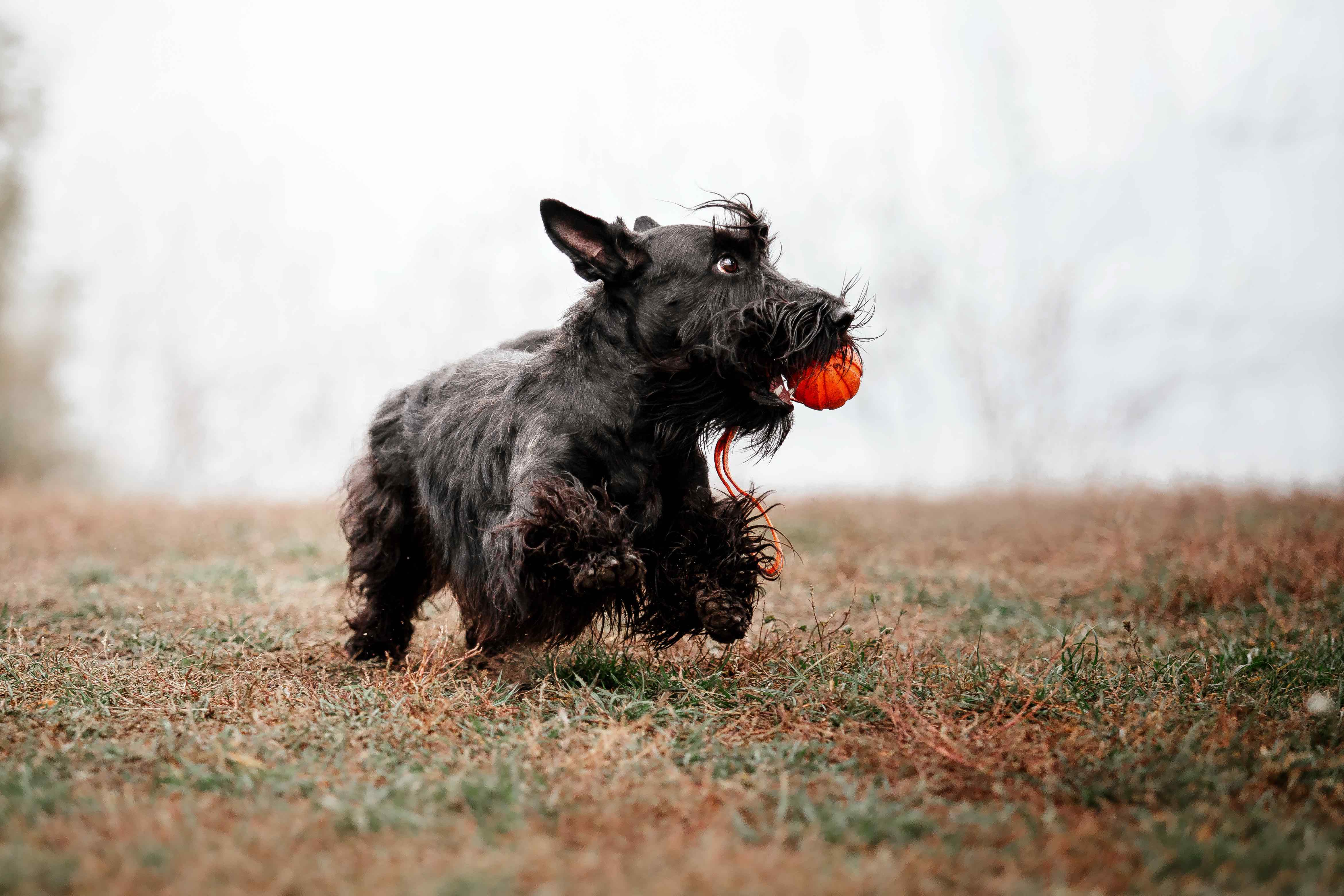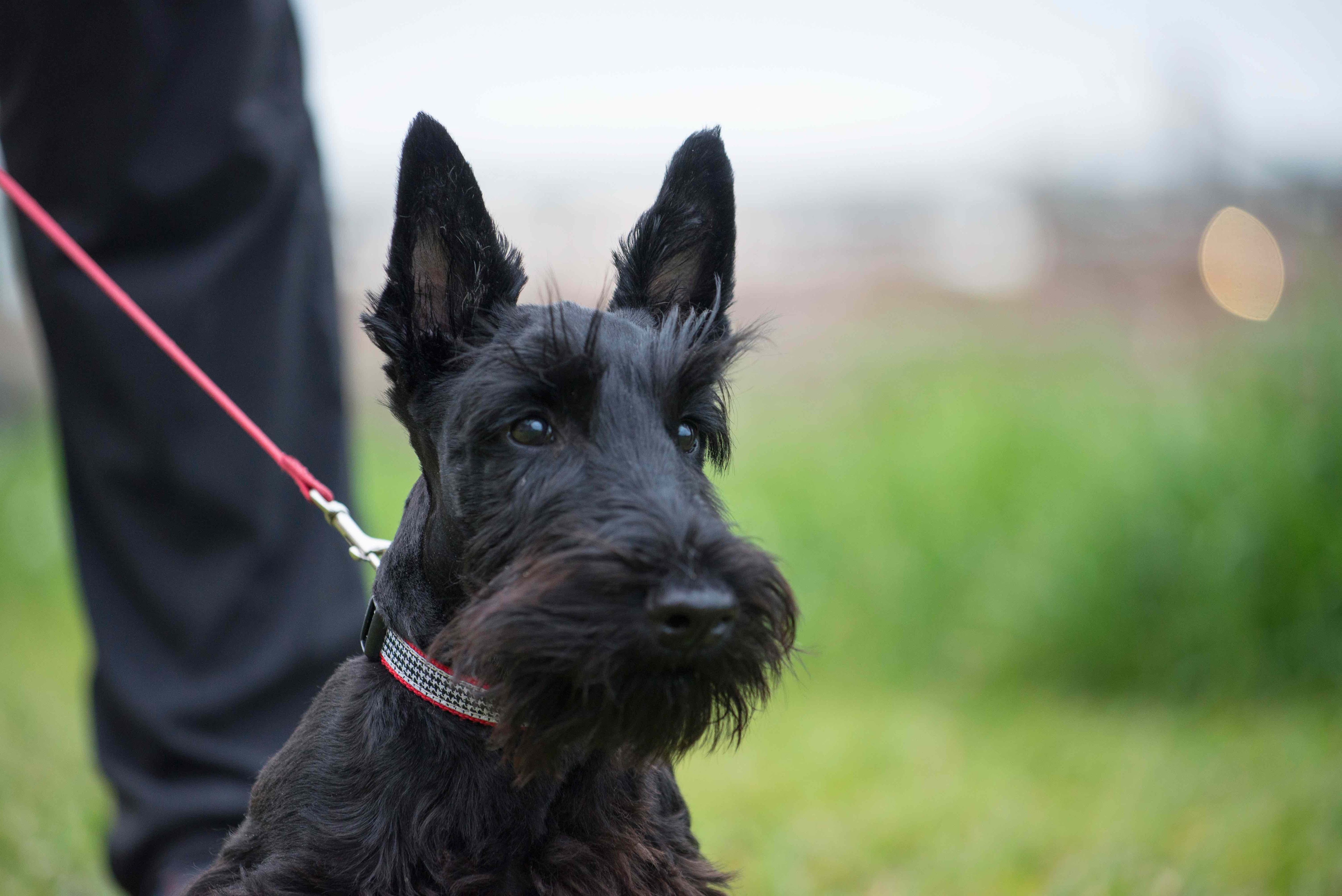Scottish Terrier
Scottish Terriers, or “Scotties,” are stout and strong dogs that have been in the U.S. since the 1890s. They trace their ancestry back to early 1800s Scotland where they were bred to hunt vermin.
Standing just 10 inches tall and weighing 18–22 pounds, Scottish Terriers are small dogs, but that doesn’t mean they’re content to stay inside all day. They’re spirited and confident dogs that need consistent exercise and lots of mental stimulation.
Caring for a Scottish Terrier
Scotties are an energetic breed that love spending time with their pet parents. They need regular, but not constant, exercise and stimulation to live a happy life. According to the Scottish Terrier Club of America (STCA), they need to run, fetch toys, and go on long walks every day.
Along with exercise and stimulation, pet parents need to prioritize grooming their Scottish Terrier. They’re not overly high-maintenance dogs, according to the STCA, but Scotties need to be bathed, hand-stripped, and/or clipped every two or three months. Make sure you have the budget for professional grooming appointments or the time to groom your dog yourself before bringing home a Scottish Terrier puppy.
Scottish Terrier Health Issues

Scottish Terriers are generally a healthy breed that usually live to be around 12 years old, on average. But Scotties are also prone to a few genetic conditions that pet parents need to be aware of. Investing in pet insurance may be a good choice for families with a Scottie.
Scottie Cramp
Scottish Terriers can develop a genetic disorder where the neurotransmitter that controls their muscles malfunctions, resulting in episodes that resemble a seizure. Symptoms vary, but affected Scotties may experience:
-
An arched back
-
A stiff walk
-
Rolling to the side
-
Muscle spasms
Dogs with Scottie Cramp often experience these episodes right after strenuous activity or moments of excitement or stress. The condition isn’t painful and won’t affect a dog’s quality of life, and pet parents can work with a vet to manage the episodes.
Von Willebrand Disease (vWD)
Von Willebrand Disease is a genetic condition that makes it difficult for blood to clot properly, which can lead to excessive bleeding. Pet parents should work with their Scottish Terrier breeder to make sure their puppy’s parents were tested for the condition.
Dogs with vWD can lead normal lives with the proper care, but warning signs include easy bruising and bleeding from even slight wounds.
Liver Shunt
A liver shunt is when there’s an abnormal connection between blood vessels, which causes blood to bypass the liver. When this happens, toxins don’t get filtered out of the bloodstream, causing:
-
Stunted growth
-
Disorientation
-
Circling
Treatment depends on the severity, but often requires surgery and medical management.
Cerebellar Abiotrophy (CA)
Cerebellar abiotrophy is a neurologic disorder that causes a lack of coordination. Affected Scottish Terrier puppies are born without symptoms, but a wobbly gait will develop over months or years.
CA is not a painful disease, but it does progress throughout the dog’s life and can make it difficult for your Scottie to run, go up or down stairs, or do other physical activities.
Hypothyroidism
Hypothyroidism happens when a dog’s thyroid gland doesn’t produce enough thyroid hormone. Signs of hypothyroidism include:
-
Unexplained weight gain
-
Heat-seeking behavior
-
Dry and brittle fur
-
Increased skin infections and ear infections
If you notice any of these symptoms, talk to your veterinarian to run full blood tests to understand the issue. Dogs with hypothyroidism can live long and normal lives with weight and medical management.
What To Feed a Scottish Terrier
Scottish Terriers need to eat a dog food that meets the nutritional standards set by the Association of American Feed Control Officials (AAFCO). They should also eat a food specifically tailored to their life stage (puppy, adult, or senior).
Work with your veterinarian to choose the best food for your dog.
How To Feed a Scottish Terrier
Scotties do well with at least two meals each day, instead of eating one large meal. Scottish Terrier puppies need to eat more frequently than adult dogs (three or four meals per day).
Scotties are highly intelligent dogs and may benefit from puzzle feeders, treat dispensers, or snuffle mats to mentally stimulate them during mealtime.
How Much Should You Feed a Scottish Terrier?
The amount you need to feed your Scottie depends on your individual dog’s health, lifestyle, and size. You can follow portion guidance on your AAFCO-approved dog food packaging, but your veterinarian will give you the best advice for how much to feed your dog.
Nutritional Tips for Scottish Terriers
Healthy Scottish Terriers shouldn’t need supplementation if they are eating an AAFCO-approved dog food. However, if your vet deems it necessary, supplements or a prescription diet may be recommended.
Behavior and Training Tips for Scottish Terriers
Scottish Terrier Personality and Temperament

Though loyal and loving toward their family, a Scottish Terrier’s personality can be pretty independent. Many will want to lie beside you rather than cuddle in your lap, and Scotties can do OK when home alone. However, you shouldn’t leave your dog alone for extended periods (more than four hours at once, according to the STCA). Separation anxiety can be a concern for these dogs.
Scottish Terrier Behavior
Scotties are incredibly curious and, thanks to their terrier genes, natural-born hunters with a strong prey drive. Because of this, they must be on a leash or inside a fenced yard whenever they’re outside. If they are left unsupervised in a yard, make sure the fence can’t be jumped, scaled, or dug under; Scotties are notorious diggers.
Their prey drive also means introductions to smaller animals, including cats, should be done properly and slowly. Scottish Terriers, like every dog, need to be properly trained and well-socialized to be OK around other animals, new people, and children.
Scottish Terrier Training
Though Scottish Terriers are smart, training can take time and patience due to their independent nature. Always use positive reinforcement methods and keep training sessions short, fun, and engaging.
Socializing your Scottish Terrier puppy is important for having a well-mannered, confident dog. Ask your breeder how they have approached socialization during the pup’s first few weeks of life, and continue to expose your new family member to new scenarios as soon as you bring them home.
Fun Activities for Scottish Terriers
-
Obedience training
-
Nose work
-
Fetching toys
Scottish Terrier Grooming Guide
Scottish Terriers have a double coat that can be black, brindle, silver, red, or wheaten. No matter the color, the coat doesn’t shed a lot—but it will shed more if you don’t properly care for it.
Skin Care
Scotties do not have robust skin care needs outside of regular bathing. Contact your veterinarian if you notice any changes in your dog’s skin, as recurring skin infections can be a sign of hypothyroidism (a common condition in Scottish Terriers).
Coat Care
Scotties are instantly recognizable thanks to their shaggy coat and iconic beard. But the look requires some work to keep them from matting.
The Scottish Terrier’s coat has two layers: a weather-resistant outer coat and a soft undercoat. Their fur grows continuously, so it needs to be clipped or hand-stripped (a process where the hair is removed from the root to protect the natural wiry texture) every two or three months. A professional groomer can help you stay on top of grooming needs, but it’s up to the pet parents to keep their dog’s fur brushed at home every few days.
Eye Care
Make sure to keep Scotties’ eyes clear of debris, and look out for changes such as cloudiness or discharge. Talk to your veterinarian if you have concerns.
Ear Care
Talk to your veterinarian about how often you should clean your dog’s ears, and be alert for signs of an ear infection.
Considerations for Pet Parents

Just because Scotties are independent dogs doesn’t mean they like to be left alone: The breed does best in a home where they receive plenty of attention. They can do well in apartments if their family is dedicated to giving them outdoor exercise, but Scottish Terriers thrive in a home with fenced yards where they can run, play, and sniff.
Keeping your Scottie entertained is vital, as a bored terrier can become destructive (i.e., dig up your flower bed). Dedicate time every day to exercising and mentally stimulating this pup.
Scottish Terrier FAQs
Is a Scottish Terrier a good family dog?
With the right training and socialization, Scottish Terriers can be good dogs for families. Make sure your children know how to properly interact appropriately with dogs, and remember that all interactions between kids and any dog should be supervised.
How much does a Scottish Terrier cost?
Scottish Terrier puppies can cost $500 or more, depending on many factors including bloodline, breeder, and location.
Are Scottish Terriers cuddly?
Scottish Terriers love being around their family and form close bonds with their humans, but they don’t have a reputation for being cuddly. According to the breed club, Scotties are more likely to want to sit beside you than in your lap.
Featured Image: Andrey Kanyshev/iStock / Getty Images Plus via Getty Images
